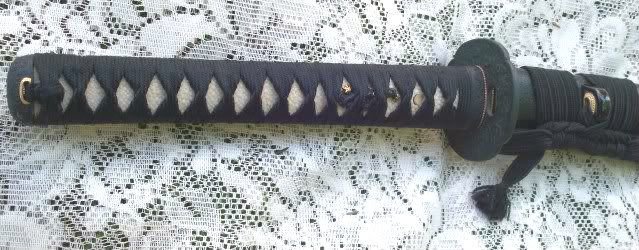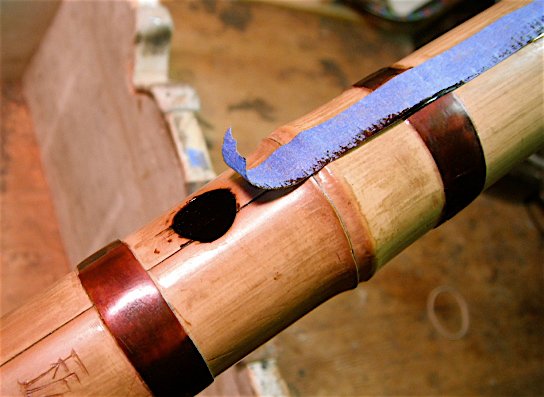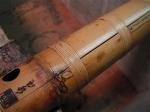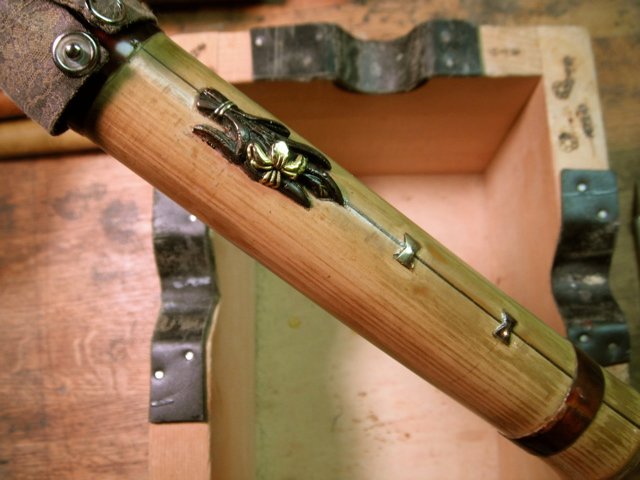Shakuhachi Crack Decoration
These raised relief sculptures are called menuki, in Japanese. This is one of two ornaments which seat underneath the criss-crossed, braided silk wrapping on a katana or wakizashi sword's elongated handle, called the tsuka (directly beneath the palms of the swords-person wielding the weapon).
Katana are Japanese long swords and wakizashi are Japanese short swords. Together, the two are paired together as a set, called daisho. Samurai carried daisho as a sign of social rank and status (and to cut their unfortunate opponents). Just reference any Kurosawa movie featuring traditional Samurai warriors.
Menuki provide both artistic and functional contributions to the overall design parameters of a Japanese sword. Ironically, they are very usually quite delicate and often depict flowers or other pretty natural motifs. Along with the tsuba (sword guard), they are some of the loveliest works of miniature, raised Japanese sculpture, admired/studied by sword collectors and aficionados.
This one probably sits atop a blob of urushi/lacquer or epoxy, sealing the crack and covering the damage to the underlying bamboo. An interesting thing to see on a shakuhachi, eh?

Katana are Japanese long swords and wakizashi are Japanese short swords. Together, the two are paired together as a set, called daisho. Samurai carried daisho as a sign of social rank and status (and to cut their unfortunate opponents). Just reference any Kurosawa movie featuring traditional Samurai warriors.
Menuki provide both artistic and functional contributions to the overall design parameters of a Japanese sword. Ironically, they are very usually quite delicate and often depict flowers or other pretty natural motifs. Along with the tsuba (sword guard), they are some of the loveliest works of miniature, raised Japanese sculpture, admired/studied by sword collectors and aficionados.
This one probably sits atop a blob of urushi/lacquer or epoxy, sealing the crack and covering the damage to the underlying bamboo. An interesting thing to see on a shakuhachi, eh?


Last edited by Jon Palombi on 2012-04-21, 02:32; edited 3 times in total
"Brian Tairaku Ritchie""Brian Tairaku Ritchie"What is it, a doorknob?
Looks like a flower bouquet.
"Jon Palombi""Jon Palombi"... Ironically, they are very usually quite delicate and often depict flowers or other pretty natural motifs....This one probably sits atop a blob of epoxy, sealing the crack and covering the damage to the underlying bamboo.
An interesting thing to see on a shakuhachi, eh?
"Yuusui""Yuusui"A sword enthusiast I showed the flute to thought that it might be Shobu flowers.
I wholly agree. Iris sanguinea is frequently found decorating Samurai weapons (as do butterflies, birds, kiku flowers and fierce dragons). The ruffled petals and bundled, Japanese Iris foliage are a dead giveaway. The menuki looks as if it may well be from the 18th or 19th century. It's hard to say from a photograph, though. How old is this shakuhachi?
"Perry Yung""Perry Yung"There are gold butterfly nails holding the crack so I have a feeling this menuki might be be hiding some tiny cracks often caused by these nails.
Perry, what adhesives do you traditionally use to fill cracks in bamboo? Sorry about my profane mention of the "epoxy" word.

Jewelers fall victim to projecting their own contemporary terminology on other art forms, and chemical glues are certainly NOT traditional adhesives. What do you prefer to use? Also, what are your thoughts on the age of this flute?
Thanx, Jon
_________________
I don't know the age of the flute, but I would guess the last fifty years or so. Any thoughts Perry? It is kinko, not the highest quality, but it has a couple other interesting features to me. The joint fittings are copper and the bindings were covered in cherry bark. I sure like the look of that cherry bark.
"Yuusui""Yuusui"I don't know the age of the flute, but I would guess the last fifty years or so. Any thoughts Perry? It is kinko, not the highest quality, but it has a couple other interesting features to me. The joint fittings are copper and the bindings were covered in cherry bark. I sure like the look of that cherry bark.
Hey Yuusui, I forgot that this was your Forum handle! I meant to reply sooner but have been working on the Momotaro show:
http://yungflutes.com/blog/entry/shakuhachi_in_momotaro_peach_boy_japan_soc…
The flute is about 50 years old more or less. It's playing full now after I made the joint snug with urushi but a leak could also have been closed by the humidity required to polymerize the lacquer. I'm leaving it out unwrapped to see if the leak will come back. It's been rainy the last few days here so it may not open up until the humidity clears. It has a very nice expansive tone and is a quite a responsive instrument.
The leak could have come from the crack that went through the thumb hole. That's a very common place for leaking.

This is my tape method for determining the exact location of a leak on an existing crack. I should know more in a few days.
"Jon Palombi""Jon Palombi"
Perry, what adhesives do you traditionally use to fill cracks in bamboo? Sorry about my profane mention of the "epoxy" word. Embarassed Jewelers fall victim to projecting their own contemporary terminology on other art forms, and chemical glues are certainly NOT traditional adhesives. What do you prefer to use?
Hi Jon, the glue in the cracks of this flute is Cyanoacrylate - super glue. I only fill gaps after the bindings are on and settled. Often times, gaps will open between the bindings, but this is just a a visual or cosmetic issue as the flute will still play well if the bindings are properly done. In these cases, I use CA glue mixed with bamboo dust. First, I use gap filling glue that seeps into the crack. Then it's topped off the bamboo dust and another layer of glue to try to match the surface. (It's an involved process that I can't get into now). The flute below just came in yesterday. It's playing fine but the external gaps can be annoying to the player.

The contemporary shakuhachi makers I met in Japan use modern adhesives when the job requires it. Tom Deaver once mentioned using modern glue (or something to that effect) while meeting with Yokoyama Rampo, a great and historically significant shakuhachi maker, and asked his opinion on it since it wasn't traditional. Rampo responded with something like, "Well, does it work?".
However, there are some traditional shakuhachi making materials that can't be beat. After experimenting with different kinds of synthetic lacquers over the years, I can say that urushi lacquer is the best for the joint and bore. Nothing beats the real thing.

Peace, Perry
Répondre

